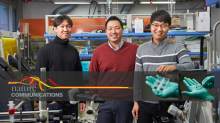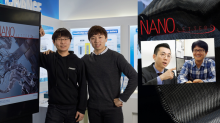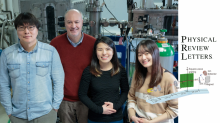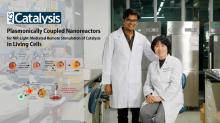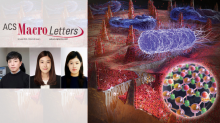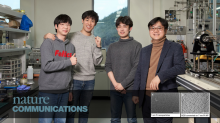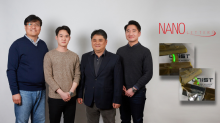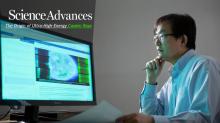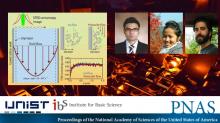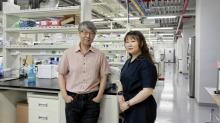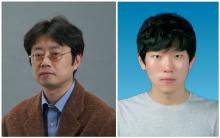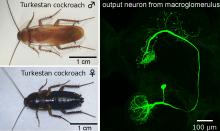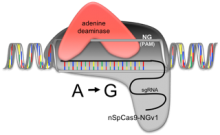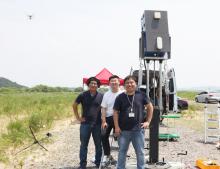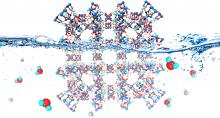Science
News
26 Aug 2019
A joint research team, affiliated South Korea's Ulsan National Institute of Science and Technology (UNIST) has developed a high-performance metal electrode (carbon fiber-metal composite) through a process of penetrating liquid metal into fine gaps of carbon fiber.
26 Aug 2019
A recent study, affiliated with South Korea's Ulsan National Institute of Science and Technology (UNIST) has laid a solid foundation for further study of dispersive interaction by verifiying a new mechanism for matter-wave diffraction.
26 Aug 2019
A recent study, affiliated with South Korea's Ulsan National Institute of Science and Technology (UNIST) has introduced a pressure-free approach for creating synthetic graphite with well-oriented crystallites.
26 Aug 2019
A recent study, affiliated with South Korea's Ulsan National Institute of Science and Technology (UNIST) has introduced an artificial catalytic reactor that can take control of chemical reactions inside living cells, as desired.
26 Aug 2019
A recent study, affiliated with South Korea's Ulsan National Institute of Science and Technology (UNIST) has gained sufficient attention among researchers for introducing a powerful antifouling material, inspired from marine plants.
26 Aug 2019
A recent study, affiliated with South Korea's Ulsan National Institute of Science and Technology (UNIST) has introduced a novel technology, capable of fabricating highly ordered arrays of graphene quantum dot (GQD). This research has gained much attention from academia since it was introduced in the February 2019 issue of Nature Nanotechnology.
26 Aug 2019
A recent study, affiliated with South Korea's Ulsan National Institute of Science and Technology (UNIST) has presented a new perovskite light-emitting diodes (PeLEDs) with high flexibility.
26 Aug 2019
A recent study, affiliated with South Korea's Ulsan National Institute of Science and Technology (UNIST) has shed new light on the mysterious origin of such ultra-high-energy cosmic rays (UHECRs) that has puzzled astrophysicists for decades.
22 Aug 2019
New microscopy technique provides unprecedented insight into nanoscopic slip layers formed in flowing complex liquids.
19 Aug 2019
DGIST Professor Jaeheung Cho in the Department of Emerging Materials Science secured materials that lead aldehyde deformylation reaction. Confirmed the nucleophilic reactions by biomimetic materials… Expects to bring positive impacts on related research.

19 Aug 2019
Phase H is a hydrous mineral that is considered to be an important carrier of water into deep Earth. We determined the dissociation condition of phase H by a theoretical calculation based on quantum mechanics. Phase H decomposes at approximately 60 GPa at 1000 K. This indicates that the transportation of water by phase H may be terminated at a depth of approximately 1,500 km in the middle of the lower mantle.
16 Aug 2019
The protein that revives injured nerve cells was discovered. It is expected to present a new direction in the development of therapeutic agents for regenerating damaged brain or spinal cord nerves.
13 Aug 2019
UK Research and Innovation and its partners are funding 13 research programs, building collaborations across 10 countries, including Japan, China, Singapore and India.
09 Aug 2019
DGIST Research Fellow Jae Young Kim and Chair-professor Dae Won Moon’s team developed a mass spectrometric technology using graphene substrate and continuous wave laser without complex sample preparation. Expected to be used for precise medical diagnosis and surgery with easy high-resolution analysis image processing.
06 Aug 2019
Senior Researcher Changsoon Choi's team at DGIST and Dr. Sungwoo Chun at SKKU developed a new tactile sensor mimicking human skin. Can recognize more sensitive tactile than the existing sensors... Expected to contribute greatly to the development of artificial skin.
25 Jul 2019
Professor Jae Dong Lee’s team developed anomalous current and suggested a control mechanism by forming valley domain. Valley domain will become new killer contents of 2D semiconductor technology.

23 Jul 2019
The InterAcademy Partnership (IAP) released a new report making the case for strengthening the sciencepolicy interface in Africa to accelerate the implementation of the UN Sustainable Development Goals (SDGs) and the African Union’s (AU) STI Strategy for Africa (STISA -2024).

22 Jul 2019
Second phase includes testing of enhanced reporting for librarians and addition of Springer journals.

22 Jul 2019
Springer Nature Video offers insights, research and training material from experts/ Medicine and Professional and Applied Computing will be the first video subject collections

19 Jul 2019
A global Springer Nature survey of more than 2,500 academic book authors provides in-depth insights into perceptions of open access (OA) | Conclusions and recommendations to further increase take-up of OA books
19 Jul 2019
The Turkestan cockroach (commonly known as the red runner roach or rusty red roach), which is popular as food for pet reptiles, has an interneuron extremely sensitive to sex pheromones emitted by American cockroaches.
19 Jul 2019
Researchers in Japan have developed a new genome editing technology in rice.
19 Jul 2019
Meet the Key Opinion Leaders
18 Jul 2019
DGIST made Small AESA radar system with a super-resolution algorithm. Expects to make huge contributions to strengthening of Korean industries and defense capabilities with domestic technology.
17 Jul 2019
A molecule-trapping material that normally degrades in water remains stable after two years of humidity exposure when treated with a common skin bleach.
17 Jul 2019
- Can analyze 100 times more data 14 times faster than existing technology
- Expected to be used in big data machine learning and various industry fields in the future

16 Jul 2019
New insight into a protein’s role in regulating tight DNA packing could have implications for combating tumor cell resistance to anti-cancer treatments.
Giants in history
Chinese biochemist Chi Che Wang (1894 - 1979), one of the first Chinese women to study abroad, advanced to prominent research positions at American institutions including the University of Chicago and the Northwestern University Medical School.
Ruby Sakae Hirose (1904 – 1960) was a Japanese-American scientist whose research contributed significantly to our understanding of blood clotting, allergies and cancer.
Chinese electron microscopy specialist Li Fanghua (6 January 1932 – 24 January 2020) facilitated the high-resolution imaging of crystal structures by eliminating interference.
Sálim Moizuddin Abdul Ali (12 November 1896 – 20 June 1987), commonly referred to as the Birdman of India, was the first person to conduct systematic surveys of birds from across India.
Haisako Koyama (1916 – 1997) was a Japanese solar observer whose dedication to recording sunspots – cooler parts of the sun’s surface that appear dark – produced a sunspot record of historic importance.
Michiaki Takahashi (17 February 1928 – 16 December 2013) was a Japanese virologist who developed the first chickenpox vaccine.
Toshiko Yuasa (11 December 1909 – 1 February 1980) was the first Japanese female physicist whose research on radioactivity shed light on beta decay – the process in which an atom emits a beta particle (electron) and turns into a different element.
Angelita Castro Kelly (1942-2015) was the first female Mission Operations Manager (MOM) of NASA. She spearheaded and supervised the Earth Observing System missions during its developmental stage.
Malaysia’s first astrophysicist, Mazlan binti Othman (born 11 December 1951) was instrumental in launching the country’s first microsatellite, and in sending Malaysia’s first astronaut, Sheikh Muszaphar Shukor, into space.
Known as Mr. Natural Rubber, chemist and researcher B. C. Shekhar (17 November 1929 – 6 September 2006) introduced a number of technical innovations that helped put Malaysia’s natural rubber industry on the world map.
Shinichiro Tomonaga (31 March 1906 – 8 July 1979), together with Richard Feynman and Julian Schwinger, was awarded the Nobel Prize in Physics in 1965, for their contributions to advance the field of quantum electrodynamics. Tomonaga was also a strong proponent of peace, who actively campaigned against the proliferation of nuclear weapons and promoted the peaceful use of nuclear energy.
South Korean theoretical physicist Daniel Chonghan Hong (3 March 1956 – 6 July 2002) achieved fame in the public sphere through his research into the physics of popcorn.
Japanese chemist Kenichi Fukui (4 October 1918 – 9 January 1998) was the first Asian scientist to be awarded the Nobel Prize in Chemistry. Together with Roald Hoffman, he received this honour in 1981 for his independent research into the mechanisms of chemical reactions.
Chinese palaeontologist, archaeologist and anthropologist Pei Wenzhong (January 19, 1904 – September 18, 1982) is regarded as a founder of Chinese anthropology.
Physicist Narinder Singh Kapany (31 October 1926 – 4 December 2020) pioneered the use of optical fibres to transmit images, and founded several optical technology companies. Born in Punjab, India, he worked at a local optical instruments factory before moving to London for PhD studies at Imperial College. There, he devised a flexible fibrescope to convey images along bundles of glass fibres.
Japanese physicist Ukichiro Nakaya (1900-1962) made the world’s first artificial snowflakes. He started his research on snow crystals in the early 1930s at Hokkaido University, where there is an unlimited supply of natural snow in winter. By taking over 3,000 photographs, he established a classification of natural snow crystals and described their relationship with weather conditions.
The field of solid-state ionics originated in Europe, but Takehiko Takahashi of Nagoya University in Japan was the first to coin the term ‘solid ionics’ in 1967. ‘Solid-state ionics’ first appeared in 1971 in another of his papers, and was likely a play on ‘solid-state electronics’, another rapidly growing field at the time.
Charles Kuen Kao (Nov. 4, 1933 to Sept. 23, 2018) was an engineer who is regarded as the father of fibre optics. His work in the 1960s on long distance signal transmission using very pure glass fibres revolutionized telecommunications, enabling innovations such as the Internet.
Chika Kuroda (24 March 1884 – 8 November 1968) was a Japanese chemist whose research focussed on the structures of natural pigments.
Motoo Kimura (13 November 1924 – 13 November 1994) was a Japanese theoretical population geneticist who is best remembered for developing the neutral theory of molecular evolution.
Meghnad Saha (6 October 1893 – 16 February 1956) was an Indian astrophysicist best known for formulating the Saha ionization equation which describes the chemical and physical properties of stars.
Sir Jagadish Chandra Bose (30 November 1858 – 23 November 1937) was a scientist and inventor who contributed to a wide range of scientific fields such as physics, botany and biology.
Osamu Shimomura (27 August 1928 – 19 October 2018) was a Japanese organic chemist and marine biologist who dedicated his career to understanding how organisms emitted light.
Subrahmanyan Chandrasekhar (19 October 1910 – 21 August 1995) was an Indian astrophysicist who studied the structure and evolution of stars.
Joo-myung Seok (November 13, 1908 – October 6, 1950) was a Korean butterfly entomologist who made important contributions to the taxonomy of the native butterfly species in Korea.
Mathematician Maryam Mirzakhani (12 May 1977 – 14 July 2017) was the first and only woman and Iranian to date to win the Fields Medal in 2014 for her work on curved surfaces.
Sir Chandrasekhara Venkata Raman (7 November 1888 – 21 November 1970) was an Indian physicist who performed ground-breaking research in the field of light-scattering.
Mohammad Abdus Salam (29 January 1926 – 21 November 1996) was a theoretical physicist and the first Pakistani to receive a Nobel Prize in science.
Srinivasa Ramanujan (22 December 1887 – 26 April 1920) was a math prodigy and widely considered one of India’s greatest mathematicians. Despite having almost no formal training in mathematics, he made substantial contributions to mathematical analysis, number theory, infinite series and continued fractions.
Gopalasamudram Narayanan Ramachandran (8 October 1922 – 7 April 2001) is best known for developing the Ramachandran plot to understand the structure of short chains of amino acids, known as peptides.
Hitoshi Kihara (1893 – 1986) was one of the most famous Japanese geneticists of the 20th century. One of his most significant contributions was identifying sex chromosomes (X and Y) in flowering plants.
Chien-Shiung Wu (31 May 1912 – 16 February 1997) was an experimental physicist who made several important contributions to nuclear physics. Wu worked on the Manhattan Project – a top-secret program for the production of nuclear weapons during World War II and helped to develop a process for separating uranium into U235 and U238.
Meemann Chang (born 17 April 1936) is a Chinese palaeontologist who studied the fossils of ancient fish to understand the evolution of life. By examining fossils, she uncovered new insights on how vertebrates, animals with a backbone, migrated from the sea and became adapted to live on land.
Bibha Chowdhuri (1913 – 2 June 1991) was an Indian physicist who researched on particle physics and cosmic rays. In 1936, she was the only female to complete a M.Sc. degree at the University of Calcutta.
Lin Lanying (7 February 1918 – 4 March 2003) was a Chinese material engineer remembered for her contributions to the field of semiconductor and aerospace materials. Lanying was born into a family who did not believe in educating girls and she was not allowed to go to school.
Japanese geochemist Katsuko Saruhashi developed the first method and tools for measuring carbon dioxide in seawater


